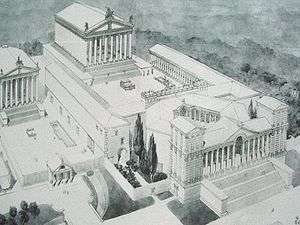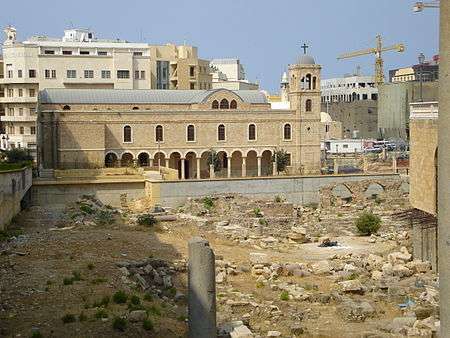Phoenicia under Roman rule

The Phoenicia under Roman rule relates to the Roman control of Syro-Phoenician city states (in the area of modern Lebanon), that lasted from 64 BC to the Muslim conquests of the 7th century.
History

The last century of Seleucid rule in Lebanon was marked by disorder and dynastic struggles. These ended in 64 BC, when the Roman general Pompey added Seleucid Syria and Lebanon to the Roman Empire.
Part of a series on the |
||||||||
|---|---|---|---|---|---|---|---|---|
| History of Lebanon | ||||||||
 | ||||||||
| Prehistory | ||||||||
| Ancient | ||||||||
|
||||||||
| Classical | ||||||||
|
||||||||
| Medieval | ||||||||
|
||||||||
| Modern | ||||||||
|
||||||||
| Timeline | ||||||||
|
| ||||||||
Economic and intellectual activities flourished in Lebanon during the Pax Romana. The inhabitants of the principal Phoenician cities of Byblos, Sidon, and Tyre were granted Roman citizenship. These cities were centers of the pottery, glass, and purple dye industries; their harbors also served as warehouses for products imported from Syria, Persia, and India. They exported cedar, perfume, jewelry, wine, and fruit to Rome.
Economic prosperity led to a revival in construction and urban development; temples and palaces were built throughout the country, as well as paved roads that linked the main cities like Baalbeck and Berytus. Indeed, starting in the last quarter of the 1st century BCE (reign of Augustus) and over a period of two centuries (reign of Philip the Arab), the Romans built a huge temple complex in Baalbek on a pre-existing tell dating to the PPNB,[1] consisting of three temples: Jupiter, Bacchus and Venus. On a nearby hill, they built a fourth temple dedicated to Mercury.
Phoenicians would ascend to the throne of Rome during the Severan dynasty. The city of Baalbeck (then called Heliopolis) was made a colonia by Septimius Severus (193-211) in 193 AD, having been part of the territory of Berytus on the Phoenician coast since 15 BC. Work on the religious complex there lasted over a century and a half and was never completed. The dedication of the present temple ruins, the largest religious building in the entire Roman empire, dates from the reign of Septimus Severus, whose coins first show the two temples. The great courts of approach were not finished before the reigns of Caracalla (211-217 CE) and Philip the Arab (244-249 CE). In commemoration of the dedication of the new sanctuaries, Severus conferred the rights of the ius Italicum on the city.Today, only six Corinthian columns remain standing of this huge Jupiter temple.
Severus also separated the area of modern Lebanon and parts of Syria from the greater province of Syria Coele, and formed the new province of Phoenice.
Furthermore, the veterans of two Roman legions were established in the city of Berytus (actual Beirut): the fifth Macedonian and the third Gallic.[2] The city quickly became Romanized. Large public buildings and monuments were erected and Berytus enjoyed full status as a part of the empire.[3]
_19.jpg)
Under the Romans, Berytus was enriched by the dynasty of Herod the Great, and was made a colonia, Colonia Iulia Augusta Felix Berytus, in 14 BC. Beirut's school of law was widely known at the time.[4] Two of Rome's most famous jurists, Papinian and Ulpian, both natives of Phoenicia, taught at the law school under the Severan emperors. When Justinian assembled his Pandects in the 6th century, a large part of the corpus of laws were derived from these two jurists, and Justinian recognized the school as one of the three official law schools of the empire in 533 AD.
Upon the death of Theodosius I in AD 395, the empire was divided in two: the eastern or Byzantine part with its capital at Constantinople, and the western part with its capital at Ravenna. Under the Byzantine Empire, intellectual and economic activities in Beirut, Tyre, and Sidon continued to flourish for more than a century.
However, in the sixth century a series of earthquakes demolished the temples of Baalbek and destroyed the city of Beirut, leveling its famous law school and killing nearly 30,000 inhabitants. To these natural disasters were added the abuses and corruptions prevailing at that time in the empire. Heavy tributes and religious dissension produced disorder and confusion. Furthermore, the ecumenical councils of the fifth and sixth centuries AD were unsuccessful in settling religious disagreements.
This turbulent period weakened the empire and made it easy prey to the newly converted Muslim Arabs of the Arabian Peninsula.[5]
Roman Temples in Lebanon
Actually, one of the best examples of Roman Temples can be seen in Lebanon. The ruins of Baalbeck are worldwide reminiscence of Roman architecture at its best. The Roman temple sites in Lebanon can be divided into three main groups. First, there is the group in the Bekaa valley north of the Beirut-Damascus road. Second, there is the group in the area south of the same road, including the Wadi al-Taym and the western flank of Mount Hermon. Third, the group in the area west of a line drawn along the ridge of Mount Lebanon. But in the coastal area of Lebanon there are not many ruins from the Roman Empire.

It will be remarked that the coastal plain of Lebanon is singularly lacking in temple remains, but it must not be thought that the principal coastal cities went unembellished during the Roman era. Berytus, Byblos, Sidon, Tyre, Tripolis, Botrys (Batroon), Caesarea ad Libanum (Arka), were all prosperous enough to have mints and to strike coins under the Romans. There were certainly temples in all these cities; the coin types are sufficient evidence for this. The reverse of a coin of Berytus, for example, illustrates a temple of Astarte (Venus); this coin was struck during the reign of Caracalla (A.D. 211-217), and has the bust of his mother, Julia Domna, on the obverse side. A similar temple appears on the Byblos coinage, and this city struck under Macrinus, the successor to Caracalla, the well-known coin depicting a temple precinct and courtyard built round a baetyl, or sacred cone. But in these urban surroundings, ashlars and column drums were too useful to lie unused; from the Byzantines to the Ottomans, temple debris - particularly the dressed blocks - was utilized in buildings. Even a cursory examination of the medieval fortifications along the coast - at Byblos, for instance - will reveal the extent of the pilfering from Roman buildings. Door frames, lintels, architraves, even altars and inscribed stelae, can be seen in the lower courses of castle and church walls..[6]
Agrippa greatly favoured the city of Berytus, and adorned it with a splendid theatre and amphitheatre, beside baths and porticoes, inaugurating them with games and spectacles of every kind, including shows of gladiators. But now only minor ruins remains, in front of the Catholic Cathedral of Beirut.
In two hundred and fifty years - from Augustus to Philip the Arab - were made all the Roman Temples, with a very similar design: they show the golden era of Roman rule in Lebanon.
See also
References
- ↑ Paolo Matthiae; Frances Pinnock; Licia Romano; Lorenzo Nigro (2010). Proceedings of the 6th International Congress of the Archaeology of the Ancient Near East: 5–10 May 2009, "Sapienza", Universita di Roma. Otto Harrassowitz Verlag. pp. 208–. ISBN 978-3-447-06216-9. Retrieved 2 May 2011.
- ↑ Roman Berytus: a colony of legionaries
- ↑ About Beirut and Downtown Beirut, DownTownBeirut.com. Retrieved November 17, 2007.
- ↑ Beirut, Britannica.com
- ↑ http://lcweb2.loc.gov/cgi-bin/query/r?frd/cstdy:@field(DOCID+lb0017)
- ↑ The Roman Temples of Lebanon, by George Taylor
Bibliography
- Beydoun, Ahmad. Le Liban, une histoire disputée: identité et temps dans l'histoire libanaise contemporaine Beyrouth, Publications de l'Université Libanaise, 1984.
- Carter, Terry & Dunston, Lara. Libano Torino, EDT, 2004. ISBN 88-7063-748-4
- Hall, Linda J. Roman Berytus: Beirut in late antiquity. Psychology Press. London, 2004 ISBN 978-0-415-28919-1
- Sartre, Maurice. Les provinces de Méditerranée orientale d'Auguste aux Sévères. Points. Paris, 1997.
External links
- 360 Panorama of the Temples of Baalbek
- The monuments of Baalbek in panorama photography
- Video of Roman ruins in Lebanon